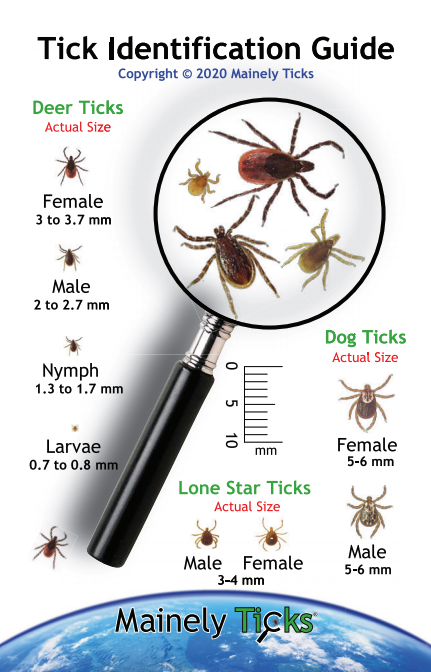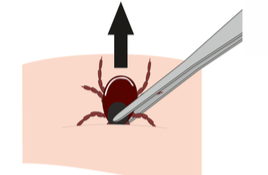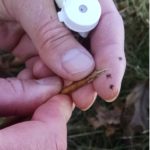Tick Identification
Use the guide below to identify the species and sex of any ticks you find on yourself, your loved one, or your pet. There are 3 primary species that each have unique features differentiating effects… the deer tick, the lone star tick, and the dog tick


Tick Growth Comparison
If you’ve removed a tick that has been attached for any amount of time, click here to see actual images of engorged ticks from TickEncounter.org to help determine tick type and number of days attached.
Tick Removal

How to remove a tick
Using a pair of fine pointed tweezers, grasp the tick as close as possible to the skin. Pull straight out with a steady motion. A tick’s mouthpart is barbed like a fish-hook. It may take several minutes of applying steady pressure for the tick to let go. Avoid squishing the tick or pulling side-to side.
Once removed
- Wash the site thoroughly with soap and water, disinfect with antiseptic.
- If black-legged tick was engorged, contact your physician for treatment.
- Early signs and symptoms of Lyme disease may include an expanding red rash, flu-like symptoms, and/or joint pain and swelling. Only 40% to 70% of Lyme disease victims may develop a rash within two days to four weeks. If untreated, more severe symptoms may develop, sometimes months to years later.
- Fill out a record of tick removal form.
Record of Tick Removal
- The date and time the tick was removed.
- Whether the tick was attached to a person or animal.
- If attached to a person, age and sex.
- If attached to an animal, was it a dog, cat or other animal?
- Note the body part that the tick was attached to.
- Visible rash or other symptoms?
- Town & state where the tick was acquired.
- Positive identification of the tick species?
Contact individual testing facilities to see if additional information is required.
Tick Submission
In some tick endemic areas of the country, as many as 40-70% of deer ticks are infected with the Borrelia burgdorrifi spirochete, the Lyme disease bacteria. You won’t be able to tell if a tick is infected by simple looking at it, whatever the size. If you remove a deer tick from yourself, family member, or pet, here are the steps to take to preserve and submit the tick for simple identification by your physician or vet, or for a complete pathogen analysis from an independent testing laboratory.
- If you’ve removed an engorged tick, symptoms may begin even before the results of the tick analysis are available. Don’t wait for tick testing results to seek medical advice if symptoms develop.
- Even if a submitted tick does test positive for a pathogen, there is no guarantee that the pathogen was passed on to the patient. The longer a tick is attached, however, the greater the chance of pathogen transmission.
- Overall testing is not perfect. Continue to monitor for symptoms after the removal of any tick. Keep in mind that if you’ve removed one tick, you’ve obviously been in tick friendly habitat. There may have been other ticks attached to you, a family member, or pet that you did not find.
After Proper Removal
- Place the tick to be identified in a zip-lock bag or small vial.
- Place a small piece of wet cotton or paper towel along with the tick, as this will keep the tick from desiccating (drying out).

When submitting your tick
sample & paperwork
- Make certain to place the contents in a padded mailer and send overnight or priority carrier.
- Visit your post office to obtain small padded mailers.
Tick testing programs & laboratories
connecticut
The Connecticut Agricultural Experiment Station
Tick office information.
maine
University of Maine Cooperative Extension Service
Tick identification & testing.
massachusetts
Laboratory of Medical Zoology, UMASS Amherst
pennsylvania
East Stroudsburg University of Pennsylvania.
Mainely Ticks has no association with any of the above state agencies or independent testing laboratories. We are simply providing initial contact information. Contact info@mainelyticks.com if you know of a state agency or independent testing laboratory that should be added to this list.
